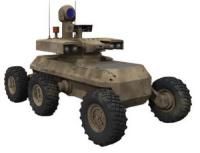-
An Expert on Search and Rescue Robots Explains the Technologies Used in Disasters Like the Florida Condo Collapse
Different types of robots may be used to search and rescue victims of disasters, such as the condo collapse in Surfside, Florida. A robotics experts says that the current state of the practice for searching the interior of rubble is to use either a small tracked vehicle, such as an Inkutun VGTV Extreme, which is the most commonly used robot for such situations, or a snakelike robot, such as the Active Scope Camera developed in Japan. Teledyne FLIR is sending a couple of tracked robots and operators to the site in Surfside, Florida.
-
-
Technique Enhances Robot Battlefield Operations
Army researchers developed a technique that allows robots to remain resilient when faced with intermittent communication losses on the battlefield. The technique, called α-shape, provides an efficient method for resolving goal conflicts between multiple robots that may want to visit the same area during missions including unmanned search and rescue, robotic reconnaissance, perimeter surveillance and robotic detection of physical phenomena, such as radiation and underwater concentration of lifeforms.
-
-
The Future of Autonomous Aircraft
Imagine a world of aerial delivery drones bringing goods right to your door, small air taxis with fewer than six passengers flying about cities, supersonic airliners crossing continents and oceans, and sixth-generation fighter aircraft patrolling battle zones – and all without the intervention or even supervision of a human pilot. That may sound like the far-off future, but it’s already arriving thanks to autonomous flight systems that may one day make pilots an optional extra.
-
-
Lethal Autonomous Weapons May Soon Make Life-and-Death Decisions – on Their Own
With drone technology, surveillance software, and threat-predicting algorithms, future conflicts could computerize life and death. “It’s a big question – what does it mean to hand over some of the decision making around violence to machines, and everybody on the planet will have a stake in what happens on this front,” says one expert.
-
-
Rwanda Has Enlisted Anti-Epidemic Robots in Its Fight against Coronavirus
Rwanda has introduced robots as part of its fight against coronavirus. With 314 confirmed cases of the virus as of May 22, the East African country has enlisted the help of five anti-epidemic robots to battle the virus. Aisha Salaudeen writes for CNN that the robots were donated by the United Nations Development Program (UNDP) to the Kanyinya treatment center that treats Covid-19 patients in the capital city, Kigali. The robots — named Akazuba, Ikirezi, Mwiza, Ngabo, and Urumuri — were received by the country’s Minister of Health and Minister of ICT and Innovation last week. hey will be used for mass temperature screening, monitoring patient status, and keeping medical records of Covid-19 patients, according to Rwanda’s Ministry of ICT and Innovation.
-
-
Emulating Snakes for Building Better Robots for Search-and-Rescue Missions
Snakes live in diverse environments ranging from unbearably hot deserts to lush tropical forests. But regardless of their habitat, they are able to slither up trees, rocks, and shrubbery with ease. Mechanical engineers design a snake robot based on the climbing technique of the kingsnake. The new design could help advance search-and-rescue technology.
-
-
Robotics Researchers Have a Duty to Prevent Autonomous Weapons
Robotics is rapidly being transformed by advances in artificial intelligence, and the benefits are widespread. But our ever-growing appetite for intelligent, autonomous machines poses a host of ethical challenges.
-
-
Bio-Inspired Theoretical Research May Improve Robots’ Effectiveness on Battlefield
In an effort to make robots more effective and versatile teammates for soldiers in combat, Army researchers are on a mission to understand the value of the molecular living functionality of muscle, and the fundamental mechanics that would need to be replicated in order to artificially achieve the capabilities arising from the proteins responsible for muscle contraction.
-
-
The Real Robot Threat
For decades, science fiction has speculated on the theme of robot servants rising up to overwhelm their human masters. Such scenarios remain fantasy, because they require self-reproducing machines with a will to power and the ability and desire to cooperate with each other to carry off a grand collective design. Instead what we have seen are drone weapons, most typically aircraft, under human command. The problem, however, occurs with proposals to eliminate human operators and allow such systems to control themselves using artificial intelligence. The problem “is that it would allow whole armies, obedient without the limiting constraint of human thought, to be commanded directly by tyrannical elites,” Robert Zubrin writers.
-
-
Coming Soon to a Battlefield: Robots That Can Kill
A Marine Corps program called Sea Mob aims to develop cutting-edge technology which would allow vessels to undertake lethal assaults without a direct human hand at the helm. A handful of such systems have been deployed for decades, though only in limited, defensive roles, such as shooting down missiles hurtling toward ships. But with the development of AI-infused systems, the military is now on the verge of fielding machines capable of going on the offensive, picking out targets and taking lethal action without direct human input.
-
-
Agile scouting robots

Researchers have developed an agile robot, called Salto, that looks like a Star Wars Imperial walker in miniature and may be able to aid in scouting and search-and-rescue operations. Robots like this may one day be used to save lives of both warfighters and civilians, researchers said.
-
-
Killer robots already exist, and they’ve been here a very long time

The question is not so much whether we should use autonomous weapon systems in battle – we already use them, and they take many forms. Rather, we should focus on how we use them, why we use them, and what form – if any – human intervention should take.
-
-
Chances of UN banning killer robots looking increasingly remote

The Campaign to Stop Killer Robots warns chances of achieving a U.N. treaty banning the development, production and use of fully autonomous lethal weapons, also known as killer robots, are looking increasingly remote. Experts from some 80 countries are attending a weeklong meeting to discuss the prospect of negotiating an international treaty.
-
-
Robots help in the demanding Fukushima cleanup efforts
In 2011, a tsunami triggered by a magnitude 9.0 earthquake all but decimated the Pacific Coast of Tohoku, Japan, including the Fukushima Daiichi power plant. A catastrophic meltdown ensued. Many tons of nuclear fuel, boiled down to a radioactive lava, corroded the steel surrounding the facility’s three reactors. Today, the cleanup effort is still projected to take several decades. S&T and NIST developed standard test methods for robots, which the Japanese government is now beginning to apply directly to their Fukushima cleanup efforts.
-
-
RoboCup 2018: Testing methods used to evaluate rescue robots
Since 1997, several continents have played host to an international soccer tournament. No, not the World Cup — the RoboCup. Robots of all shapes and sizes test their “metal” in the world’s favorite sport. Engineers and fans from across the globe have gathered to watch hunks of autonomous steel try to nudge a ball into a miniature net.
-
- All
- Regional
- Water
- Biometrics
- Borders/Immig
- Business
- Cybersecurity
- Detection
- Disasters
- Government
- Infrastructure
- International
- Public health
- Public Safety
- Communication interoperabillity
- Emergency services
- Emergency medical services
- Fire
- First response
- IEDs
- Law Enforcement
- Law Enforcement Technology
- Military technology
- Nonlethal weapons
- Nuclear weapons
- Personal protection equipment
- Police
- Notification /alert systems
- Situational awareness
- Weapons systems
- Sci-Tech
- Sector Reports
- Surveillance
- Transportation
Advertising & Marketing: advertise@newswirepubs.com
Editorial: editor@newswirepubs.com
General: info@newswirepubs.com
2010-2011 © News Wire Publications, LLC News Wire Publications, LLC
220 Old Country Road | Suite 200 | Mineola | New York | 11501
Permissions and Policies
Editorial: editor@newswirepubs.com
General: info@newswirepubs.com
2010-2011 © News Wire Publications, LLC News Wire Publications, LLC
220 Old Country Road | Suite 200 | Mineola | New York | 11501
Permissions and Policies
